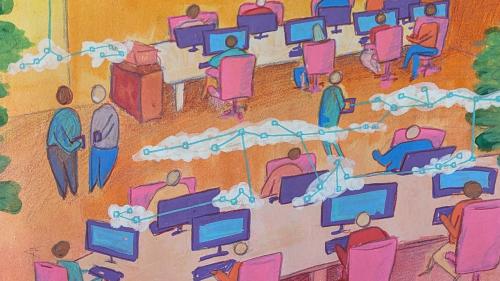The Internet has modified our daily behaviors, jobs, interests, and the way we communicate with one another. Today a new set of technologies is similarly transforming society, including local government. The Local government 2035: Strategic trends and implications of new technologies report highlights a handful of technologies that are already shifting the way that cities and municipalities govern. Local governments’ success in adopting and adjusting to these technologies will depend on their proactive efforts and preparedness.
Technology is already changing governance. The report highlights some of the varied impacts from these changes. For example, driverless cars will fundamentally alter transportation, safety, and infrastructure. Cryptocurrencies are frictionless and anonymous banking interactions. Artificial intelligence will enable robots to perform more complex tasks that could displace human workers.
Future challenges
Consider the following technologies that will arrive soon. In 2015, Japan’s magnetic levitation (MagLev) passenger train broke world speed records. MagLevs are wheel-less trains that levitate above tracks suspended by an electromagnetic field. They are expected to connect all of Japan by 2045, cutting down trips that take three hours down to less than an hour. Other developers are creating wireless electricity, which will eliminate the challenge of keeping our phones charged and offer electricity to some of the world’s poorest individuals. Scientists around the country claim that they are close to helping us find a way to regrow our teeth naturally, which would prevent tooth decay, gum disease, fillings, and root canals. Now, imagine how other innovators will improve upon these technologies.
Some might assume that because technologies are life improving that the challenges for government will be small. For instance, the Environmental Work Group estimates that food supplies will need to double by 2050 to meet growing needs. In 2014, geneticists announced that they made a major advancement in engineering rice to carryout photosynthesis more efficiently in a process called C4 photosynthesis. This process supercharges plant growth by capturing carbon dioxide, which improve the efficiency of photosynthesis. They calculate that this will have the ability to boost crop yields (mainly rice and wheat) by about 50 percent. This process should be operational in 10 to 15 years. However, the proliferation of these technologies may have unintended consequences.
Unmanned aerial vehicle (UAV) or drones have numerous nonmilitary purposes. Industries and individuals want to use drones for surveying crops, photographing weddings, and delivering packages. The founder of AeriCam has developed the Anura, a quadcopter drone that can be folded up and taken on the go. The drone connects with a smartphone and shows the view from the drones camera. Local government will struggle to regulate this new technology both to prevent accidents and privacy invasions.
Corporations are providing more data than ever before to private companies like Facebook, Airbnb, Uber, and Google. This trend presents issues for local government. Currently governments are responsible for gathering most data available for large populations. Citizens are required to submit information such as taxes, birth and death certificates, car registration, marriage licenses, and the like. In the future, policymakers will have to make decisions without access to data that exists in the private sector, which will become increasingly important.
Implications
Simple technologies such as Facebook, Twitter, and YouTube are spurring movements and revolutions that local governments cannot control. Large numbers of people are able to organize quickly because of social media. In Ferguson and Baltimore, protestors were able to quickly mobilize. To deal with different demands from their citizens, local governments will need access to data to perform services such as law enforcement and service delivery; however, they could become dependent on private entities’ data. Local governments might need to start purchasing data from private entities to conduct their operations.
Another threat is from computers that replace unskilled laborers such as postal carriers, data entry clerks, and cashiers because. MIT Professor Erik Brynjolfsson and Andrew McAfee called this the “great decoupling” where, beginning after World War II, productivity and employment were closely related. In essence, as business gained more productivity from workers, economic activity was fueled, and more jobs were created. However, this trend shifted in 2000, and by 2011, the relationship between productivity and employment were incongruous. They contribute this to the growth of technology, which helped productivity but weakened job growth.
Undoubtedly, new technologies will challenge local government. There is no way to foresee exactly how technology will grow and modify the landscape of the future. We have no idea of the next game-changer, Internet-sized innovation, so local leaders must be on notice. The evolution of technology will force government to act; how well government acts is a decision that can be made now. This report identifies a few trends to take note of. It should also help spark dialogue amongst city leaders on how they will reimagine their role and tap in to other stakeholders who will be impacted to build their capacity to confront these challenges.
The Brookings Institution is committed to quality, independence, and impact.
We are supported by a diverse array of funders. In line with our values and policies, each Brookings publication represents the sole views of its author(s).




Commentary
Local government 2035: Strategic trends and implications
June 2, 2015